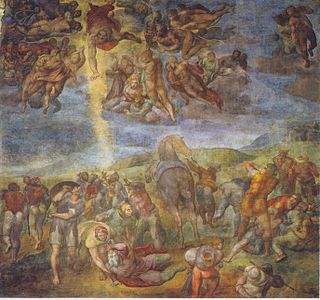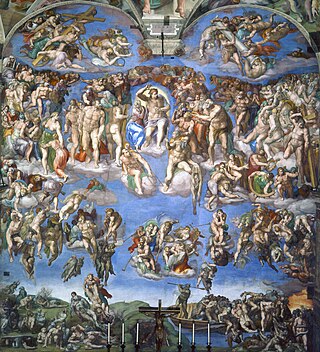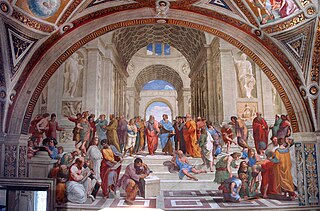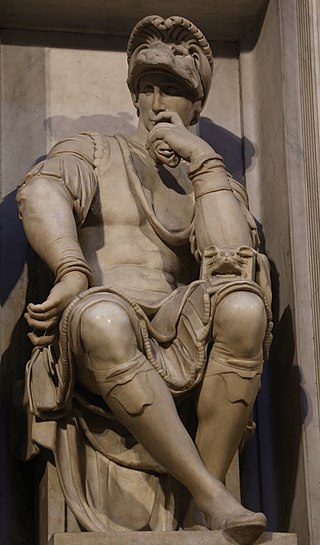
Michelangelo di Lodovico Buonarroti Simoni, known mononymously as Michelangelo, was an Italian sculptor, painter, architect, and poet of the High Renaissance. Born in the Republic of Florence, his work was inspired by models from classical antiquity and had a lasting influence on Western art. Michelangelo's creative abilities and mastery in a range of artistic arenas define him as an archetypal Renaissance man, along with his rival and elder contemporary, Leonardo da Vinci. Given the sheer volume of surviving correspondence, sketches, and reminiscences, Michelangelo is one of the best-documented artists of the 16th century. He was lauded by contemporary biographers as the most accomplished artist of his era.

The Sistine Chapel is a chapel in the Apostolic Palace, the pope's official residence in Vatican City. Originally known as the Cappella Magna, it takes its name from Pope Sixtus IV, who had it built between 1473 and 1481. Since that time, it has served as a place of both religious and functionary papal activity. Today, it is the site of the papal conclave, the process by which a new pope is selected. The chapel's fame lies mainly in the frescoes that decorate its interior, most particularly the Sistine Chapel ceiling and The Last Judgment, both by Michelangelo.

The Creation of Adam, also known as The Creation of Man, is a fresco painting by Italian artist Michelangelo, which forms part of the Sistine Chapel's ceiling, painted c. 1508–1512. It illustrates the Biblical creation narrative from the Book of Genesis in which God gives life to Adam, the first man. The fresco is part of a complex iconographic scheme and is chronologically the fourth in the series of panels depicting episodes from Genesis.

The Sistine Chapel ceiling, painted in fresco by Michelangelo between 1508 and 1512, is a cornerstone work of High Renaissance art.

The Agony and the Ecstasy is a 1965 American historical drama film directed by Carol Reed and starring Charlton Heston as Michelangelo and Rex Harrison as Pope Julius II. The film was partly based on Irving Stone's 1961 biographical novel of the same name, and deals with the conflicts of Michelangelo and Pope Julius II during the 1508–1512 painting of the Sistine Chapel ceiling. It also features a soundtrack by prolific composers Alex North and Jerry Goldsmith.

The Cappella Paolina is a chapel in the Apostolic Palace, Vatican City. It is separated from the Sistine Chapel by the Sala Regia. It is not on any of the regular tourist itineraries.

The Last Judgment is a fresco by the Italian Renaissance painter Michelangelo covering the whole altar wall of the Sistine Chapel in Vatican City. It is a depiction of the Second Coming of Christ and the final and eternal judgment by God of all humanity. The dead rise and descend to their fates, as judged by Christ who is surrounded by prominent saints. Altogether there are over 300 figures, with nearly all the males and angels originally shown as nudes; many were later partly covered up by painted draperies, of which some remain after recent cleaning and restoration.

The conservation-restoration of the frescoes of the Sistine Chapel was one of the most significant conservation-restorations of the 20th century.

Pope Julius II, commissioned a series of highly influential art and architecture projects in the Vatican. The painting of the Sistine Chapel ceiling by Michelangelo and of various rooms by Raphael in the Apostolic Palace are considered among the masterworks that mark the High Renaissance in Rome. His decision to rebuild St Peter's led to the construction of the present basilica.
Events from the year 1512 in art.
Ross King is a Canadian novelist and non-fiction writer. He began his career by writing two works of historical fiction in the 1990s, later turning to non-fiction, and has since written several critically acclaimed and best-selling historical works.

The Prophet Isaiah is a fresco located in Basilica di Sant'Agostino, an early Renaissance church in Rome. It is an Italian Renaissance painting, influenced by Michelangelo's work on the Sistine Chapel ceiling.

Michelangelo had a complicated relationship with the Medici family, who were for most of his lifetime the effective rulers of his home city of Florence. The Medici rose to prominence as Florence's preeminent bankers. They amassed a sizable fortune some of which was used for patronage of the arts. Michelangelo's first contact with the Medici family began early as a talented teenage apprentice of the Florentine painter Domenico Ghirlandaio. Following his initial work for Lorenzo de' Medici, Michelangelo's interactions with the family continued for decades including the Medici papacies of Pope Leo X and Pope Clement VII.

The Separation of Light from Darkness is, from the perspective of the Genesis chronology, the first of nine central panels that run along the center of Michelangelo's Sistine Chapel ceiling and which depict scenes from the Book of Genesis. Michelangelo probably completed this panel in the summer of 1512, the last year of the Sistine ceiling project. It is one of five smaller scenes that alternate with four larger scenes that run along the center of the Sistine ceiling. The Separation of Light from Darkness is based on verses 3–5 from the first chapter of the Book of Genesis:

The Prophet Jonah is one of the seven Old Testament prophets painted by the Italian High Renaissance master Michelangelo on the Sistine Chapel ceiling in the Vatican Palace of Vatican City.

The Prophet Jeremiah is one of the seven Old Testament prophets painted by the Italian High Renaissance master Michelangelo on the Sistine Chapel ceiling. The Sistine Chapel is in Vatican Palace, in the Vatican City.

The Prophet Isaiah is one of the seven Old Testament prophets painted by the Italian High Renaissance master Michelangelo on the Sistine Chapel ceiling. The Sistine Chapel is in Vatican Palace, in the Vatican City. Elements of this fresco have inspired various artists, including Caravaggio and Norman Rockwell in his famous Rosie the Riveter illustration.

The Prophet Joel is one of the seven Old Testament prophets painted by the Italian High Renaissance master Michelangelo on the Sistine Chapel ceiling. The Sistine Chapel is in Vatican Palace, in the Vatican City.

The Tomb of Pope Julius II is a sculptural and architectural ensemble by Michelangelo and his assistants, originally commissioned in 1505 but not completed until 1545 on a much reduced scale. Originally intended for St. Peter's Basilica, the structure was instead placed in the church of San Pietro in Vincoli on the Esquiline in Rome after the pope's death. This church was patronized by the Della Rovere family from which Julius came, and he had been titular cardinal there. Julius II, however, is buried next to his uncle Sixtus IV in St. Peter's Basilica, so the final structure does not actually function as a tomb.
Gianluigi Colalucci was an Italian Master Restorer and academic most known for being the chief restorer of the Sistine Chapel in the Vatican City from 1980 to 1994.

















